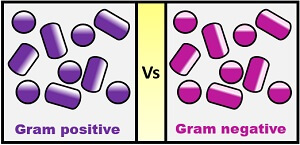

Moraxella spp are most commonly pathogens of the upper and lower respiratory tract, although they are rarely isolated from blood cultures. Other Neiserria spp are human commensal organisms as well as potential pathogens 3. Neiserria meningitidis is the cause of meningococcal sepsis and meningitis.
Gram positive vs gram negative cluster skin#
These organisms can cause a wide range of infections from head to toe, including meningitis, infective endocarditis, pneumonia, epiglottitis (and other upper respiratory tract infections), septic arthritis, osteomyelitis and skin and soft-tissue infections. They can be pleomorphic and may become coccoid, appearing as diplococci 7.īack to top Clinical differential diagnosis

They occur singly, in pairs, short chains and rosette clusters 6.Įikenella spp: Small, slender gram negative rods, that can be coccobacilli 6.Īcinetobacter spp: Gram negative coccobacilli that may retain crystal violet (gram positive) staining and so appear Gram variable. Some species produce filamentous forms 6.Ĭardiobacterium spp: Irregularly staining pleomorphic or straight rods of variable length with rounded ends, sometimes producing long filaments. They occur singly or in pairs and more rarely in short chains. Kingella spp: Short gram negative rods that often grow in pairs or short chains 6Īggregatibacter spp: Gram negative coccobacillus or short rod, although rods often predominate. Haemophilus spp: Gram negative pleomorphic cells that can be spherical, oval or varying length rods 6. Pasturella spp: Gram negative cells that can be oval, spherical or rod shaped, which occur singly, in pairs or short chains 5. Moraxella spp: Gram negative coccobacilli that grow in pairs or short chains 4. Of most concern would be neiserria meningitidis 3 Neiserria spp: Gram negative cocci that occur singly or more commonly in pairs. Gram negative cocci and coccobacilli are unusual findings in blood cultures and can represent a wide range of possible infections when they are seen.
Gram positive vs gram negative cluster how to#
How to use this guideline: Support interaction with microbiology staff (not replace interaction with microbiology staff).īack to top Bacteriological differential diagnosis (Gram guideline only) The blood culture process: Timings of culture, identification, susceptibility tests and clinical liaison. Support ward doctors in treating and investigating bacteraemic patients.Support communication of Gram stain results from microbiologists to ward doctors.Provide education to junior microbiology registrars.

Please contact Microbiology for further advice regarding investigations and/or treatment following the systemic review, if required.īack to top Gram stain: Gram negative Cocci & coccobacilli Aim The differential diagnosis for gram negative coccobacilli in particular is extensive and requires a thorough systemic review of the patient. The finding of a Gram negative coccus or coccobacillus in a blood culture is unusual. This document is supplementary to, and should be used in conjunction with, the antimicrobial guidelines. This document provides guidelines for doctors on the management of patients with confirmed bacteraemias (blood cultures). Department of Microbiology Bacteraemia guideline Gram negative cocci & coccobacilli


 0 kommentar(er)
0 kommentar(er)
